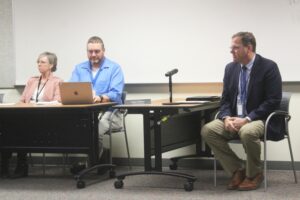Hoping to show that teachers and school district leaders can work together without contention, the Washougal Association of Educators (WAE) threw a tailgate party outside Washougal High School on May 30, to mark the start of the WAE and Washougal School District’s contract bargaining negotiations.
The district and teachers’ union agreed on a one-year bargaining contract for the 2017-18 school year on Sept. 26, 2017. That contract expires on Aug. 31.
Teachers barbecued and served snacks and desserts in front of the high school entrance on May 30, while bargaining teams from the union and the district met inside the school.
Hillary Marshall, Washougal High library media specialist, said teachers wanted to start the negotiations off in a more lighthearted way.
“We don’t want to be seen as the adversary. So, we’re going to invite the district to come out to have dinner with us, see that these are your people, and we’re all on the same page,” Marshall said. “We’re all fighting for our Washougal kids.”




